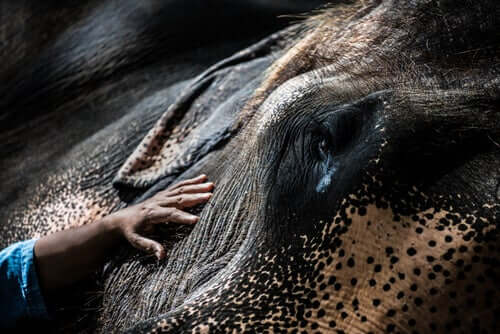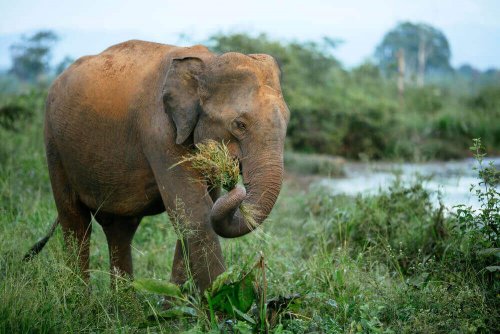5 Bacterial Diseases in Elephants


Written and verified by the vet Érica Terrón González
Have you ever thought about bacterial diseases in elephants? Do you think these could affect other species? Below, we’ll tell you more.
Elephants are strong and live for a long time, but they can still get sick.
Tuberculosis: bacterial diseases in elephants
Tuberculosis is a common bacterial infection that affects almost all animal species, such as primates, cattle, rhinos, elephants and birds.
The first case of tuberculosis in African elephants dates from 1962.

Analysis
A micro bacterium from Mycobacterium tuberculosis causes it. Human beings and cattle are natural reservoirs.
Symptoms and how it is transferred
It’s transferred by eating or breathing in bioaerosols (dust mites, skin or hair cells, pollen, fungal spores, etc.). When it comes to elephants, this happens when their trunk makes contact with another species.

Elephants don’t often show clear symptoms. Weight loss, anorexia and chronic weakness is noticeable, as well as a lack of energy. Another symptom is abnormal nasal discharge from the trunk.
Staff safety
It’s a serious and highly infectious disease. Therefore, the staff need to take the necessary steps to prevent it. They need to use specialized masks, gloves, and suits whilst dealing with sick animals. This is in addition to standard hygiene, especially washing their hands.
Anthrax: another bacterial disease in elephants
Anthrax is an acute feverish illness. It affects most domestic and wild mammals, as well as birds. It affects elephants that live in the wild more than those that live in zoos.
Analysis
Anthrax bacterium causes this. It produces very resistant spores in the environment. Ingesting these spores is what causes this infection. They enter the respiratory system, the intestine, etc., then spread throughout the body.
The severity of this disease occurs when the spores act as exotoxins. This affects clotting cascade and causes bleeding.
Symptoms and how it is transferred
There are many ways it can infect elephants. Flies and mosquitoes can carry it, and they can contaminate wounds or inject the bacteria. Other infected animals can excrete it, and this will then contaminate grass and water.
A respiratory infection can cause pneumonia and other respiratory issues. Eating the bacteria causes diarrhea. It can also cause neural damage leading to paralysis and seizures.
Salmonellosis
Salmonellosis is generally food poisoning. It occasionally causes diseases such as sepsis. The bacteria that causes it is Salmonella spp.
Symptoms and how it’s transferred
Salmonella sticks to the gastrointestinal tract of the animal which then acts as a reservoir. Animals will excrete it, which then contaminates the environment. Therefore, it can be transferred fecal-orally.
Infected elephants can suffer from anorexia, stomach cramp, and diarrhea. Sepsis can appear in serious cases.

Colibacillosis
A group of diseases caused by E.coli causes this. Some create tissue infections while others create an overeating disease. However, E.coli is part of the normal intestinal flora of animals.
Symptoms and how it’s transferred
It can be transferred fecal-orally but may vary:
- Some strains cause diarrhea from overeating
- Others cause a disease that invades tissues and causes sepsis
Mycoplasmosis
Mycoplasmosis is a serous membrane and mucous infection which can cause autoimmune disease.
Mycoplasma spp. causes this, as well as urinary tract infections. It’s also transferred when the animal eats food or drinks water that’s contaminated with the urine of sick animals.
Diagnose it early
So, many bacterial diseases can put an elephant’s health at risk. They need to be treated as soon as the first symptoms are spotted.
Therefore, good veterinary care from the start will go a long way to help them recover.
Have you ever thought about bacterial diseases in elephants? Do you think these could affect other species? Below, we’ll tell you more.
Elephants are strong and live for a long time, but they can still get sick.
Tuberculosis: bacterial diseases in elephants
Tuberculosis is a common bacterial infection that affects almost all animal species, such as primates, cattle, rhinos, elephants and birds.
The first case of tuberculosis in African elephants dates from 1962.

Analysis
A micro bacterium from Mycobacterium tuberculosis causes it. Human beings and cattle are natural reservoirs.
Symptoms and how it is transferred
It’s transferred by eating or breathing in bioaerosols (dust mites, skin or hair cells, pollen, fungal spores, etc.). When it comes to elephants, this happens when their trunk makes contact with another species.

Elephants don’t often show clear symptoms. Weight loss, anorexia and chronic weakness is noticeable, as well as a lack of energy. Another symptom is abnormal nasal discharge from the trunk.
Staff safety
It’s a serious and highly infectious disease. Therefore, the staff need to take the necessary steps to prevent it. They need to use specialized masks, gloves, and suits whilst dealing with sick animals. This is in addition to standard hygiene, especially washing their hands.
Anthrax: another bacterial disease in elephants
Anthrax is an acute feverish illness. It affects most domestic and wild mammals, as well as birds. It affects elephants that live in the wild more than those that live in zoos.
Analysis
Anthrax bacterium causes this. It produces very resistant spores in the environment. Ingesting these spores is what causes this infection. They enter the respiratory system, the intestine, etc., then spread throughout the body.
The severity of this disease occurs when the spores act as exotoxins. This affects clotting cascade and causes bleeding.
Symptoms and how it is transferred
There are many ways it can infect elephants. Flies and mosquitoes can carry it, and they can contaminate wounds or inject the bacteria. Other infected animals can excrete it, and this will then contaminate grass and water.
A respiratory infection can cause pneumonia and other respiratory issues. Eating the bacteria causes diarrhea. It can also cause neural damage leading to paralysis and seizures.
Salmonellosis
Salmonellosis is generally food poisoning. It occasionally causes diseases such as sepsis. The bacteria that causes it is Salmonella spp.
Symptoms and how it’s transferred
Salmonella sticks to the gastrointestinal tract of the animal which then acts as a reservoir. Animals will excrete it, which then contaminates the environment. Therefore, it can be transferred fecal-orally.
Infected elephants can suffer from anorexia, stomach cramp, and diarrhea. Sepsis can appear in serious cases.

Colibacillosis
A group of diseases caused by E.coli causes this. Some create tissue infections while others create an overeating disease. However, E.coli is part of the normal intestinal flora of animals.
Symptoms and how it’s transferred
It can be transferred fecal-orally but may vary:
- Some strains cause diarrhea from overeating
- Others cause a disease that invades tissues and causes sepsis
Mycoplasmosis
Mycoplasmosis is a serous membrane and mucous infection which can cause autoimmune disease.
Mycoplasma spp. causes this, as well as urinary tract infections. It’s also transferred when the animal eats food or drinks water that’s contaminated with the urine of sick animals.
Diagnose it early
So, many bacterial diseases can put an elephant’s health at risk. They need to be treated as soon as the first symptoms are spotted.
Therefore, good veterinary care from the start will go a long way to help them recover.
All cited sources were thoroughly reviewed by our team to ensure their quality, reliability, currency, and validity. The bibliography of this article was considered reliable and of academic or scientific accuracy.
- Fowler M, Mikota S. Biology, Medicine, and Surgery of Elephants. Hoboken: John Wiley & Sons; 2008
This text is provided for informational purposes only and does not replace consultation with a professional. If in doubt, consult your specialist.








